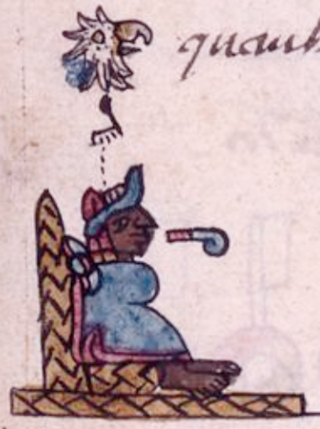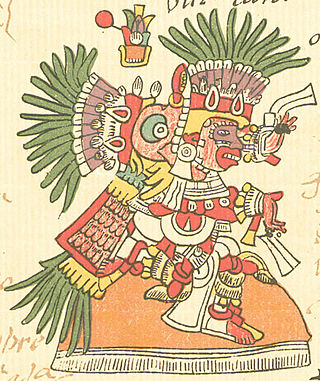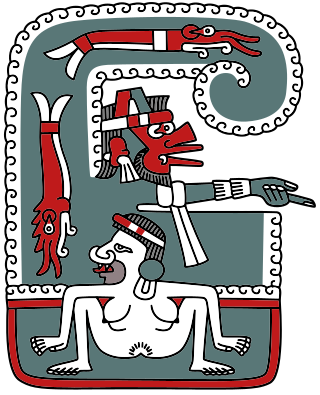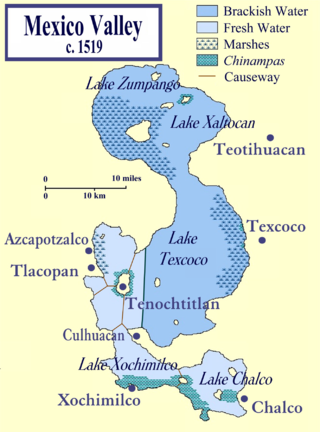Related Research Articles

Cuauhtémoc, also known as Cuauhtemotzín, Guatimozín, or Guatémoc, was the Aztec ruler (tlatoani) of Tenochtitlan from 1520 to 1521, and the last Aztec Emperor. The name Cuauhtemōc means "one who has descended like an eagle", and is commonly rendered in English as "Descending Eagle", as in the moment when an eagle folds its wings and plummets down to strike its prey. This is a name that implies aggressiveness and determination.

Moctezuma Xocoyotzin, retroactively referred to in European sources as Moctezuma II, was the ninth emperor of the Aztec Empire, reigning from 1502 or 1503 to 1520. Through his marriage with Queen Tlapalizquixochtzin of Ecatepec, one of his two wives, he was also the king consort of that altepetl.

Aztec mythology is the body or collection of myths of the Aztec civilization of Central Mexico. The Aztecs were Nahuatl-speaking groups living in central Mexico and much of their mythology is similar to that of other Mesoamerican cultures. According to legend, the various groups who became the Aztecs arrived from the North into the Anahuac valley around Lake Texcoco. The location of this valley and lake of destination is clear – it is the heart of modern Mexico City – but little can be known with certainty about the origin of the Aztec. There are different accounts of their origin. In the myth, the ancestors of the Mexica/Aztec came from a place in the north called Aztlan, the last of seven nahuatlacas to make the journey southward, hence their name "Azteca." Other accounts cite their origin in Chicomoztoc, "the place of the seven caves", or at Tamoanchan.

The Aztecs were a Mesoamerican civilization that flourished in central Mexico in the post-classic period from 1300 to 1521. The Aztec people included different ethnic groups of central Mexico, particularly those groups who spoke the Nahuatl language and who dominated large parts of Mesoamerica from the 14th to the 16th centuries. Aztec culture was organized into city-states (altepetl), some of which joined to form alliances, political confederations, or empires. The Aztec Empire was a confederation of three city-states established in 1427: Tenochtitlan, the capital city of the Mexica or Tenochca, Tetzcoco, and Tlacopan, previously part of the Tepanec empire, whose dominant power was Azcapotzalco. Although the term Aztecs is often narrowly restricted to the Mexica of Tenochtitlan, it is also broadly used to refer to Nahua polities or peoples of central Mexico in the prehispanic era, as well as the Spanish colonial era (1521–1821). The definitions of Aztec and Aztecs have long been the topic of scholarly discussion ever since German scientist Alexander von Humboldt established its common usage in the early 19th century.

Tlāhuizcalpantēcuhtli is a principal member of the pantheon of gods within the Aztec religion, representing the Morning Star Venus. The name comes from the Nahuatl words tlāhuizcalpan "dawn" and tēcuhtli "lord". Tlahuizcalpantecuhtli is one of the thirteen Lords of the Day, representing the 12th day of the Aztec trecena.

In Aztec mythology, Tonacatecuhtli was a creator and fertility god, worshipped for populating the earth and making it fruitful. Most Colonial-era manuscripts equate him with Ōmetēcuhtli. His consort was Tonacacihuatl.

In Aztec mythology, Tōnacācihuātl was a creator and goddess of fertility, worshiped for peopling the earth and making it fruitful. Most Colonial-era manuscripts equate her with Ōmecihuātl. Tōnacācihuātl was the consort of Tōnacātēcuhtli. She is also referred to as Ilhuicacihuātl or "Heavenly Lady."

Chimalman or Chīmalmā /t͡ʃiːmalmaː/ is a goddess in Aztec mythology, and was considered by the Aztecs to be the mother of the Toltec gods Quetzalcoatl and Xolotl. Her name means "shield-hand."

Huitzilihuitl or Huitzilihuitzin was the second Tlatoani or king of Tenochtitlan. According to the Codex Chimalpahin, he reigned from 1390 to 1415, according to the Codex Aubin, he reigned from 1396 to 1417 and according to the Codex Chimalpopoca, he reigned from 1403 to 1417.

Chimalpopoca or Chīmalpopōcatzin (1397–1427) was the third Emperor of Tenochtitlan (1417–1427).

La Noche Triste, officially re-branded in Mexico as La Noche Victoriosa, was an important event during the Spanish conquest of the Aztec Empire, wherein Hernán Cortés, his army of Spanish conquistadors, and their native allies were driven out of the Aztec capital, Tenochtitlan.

Ciudad Hidalgo, or simply Hidalgo, is a city and municipal seat of the Municipality of Hidalgo in the far northeast of the state of Michoacán, Mexico. It is a city located in a rural, mountainous area. While most of the city consists of modern buildings, its principal monument is the 16th-century church and former monastery of San José. Formerly, its name was Taximaroa, and it was the part of the Purépecha Empire closest to the Aztec Empire. This prompted two unsuccessful Aztec invasions as well as the first Spanish incursion into Purépecha lands in 1522. For both the city and rural communities around it, forestry and furniture making are important parts of the economy, but deforestation is forcing the area to look into alternatives such as tourism to take advantage of its natural resources and cultural sites.

The Ramírez Codex, not to be confused with the Tovar Codex, is a post-conquest codex from the late 16th century entitled Relación del origen de los indios que hábitan esta Nueva España según sus Historias. The manuscript is named after the Mexican scholar José Fernando Ramírez, who discovered it in 1856 in the convent of San Francisco in Mexico City.

The Aztecs were a Pre-Columbian Mesoamerican people of central Mexico in the 14th, 15th, and 16th centuries. They called themselves Mēxihcah.

The Spanish conquest of the Aztec Empire was a pivotal event in the history of the Americas, marked by the collision of the Aztec Triple Alliance and the Spanish Empire. Taking place between 1519 and 1521, this event saw the Spanish conquistador Hernán Cortés, and his small army of European soldiers and numerous indigenous allies, overthrowing one of the most powerful empires in Mesoamerica.

Azcapotzalco was a pre-Columbian Nahua altepetl (state), capital of the Tepanec empire, in the Valley of Mexico, on the western shore of Lake Texcoco.
Chimalpopoca was an Aztec nobleman. He is identified by some sources as a son of the Tlatoani Moctezuma II, not be confused with an earlier Aztec ruler of the same name. According to some authors he was taken out of Tenochtitlan as a prisoner with other noble men by the Spaniards during the Noche Triste, when he was killed being struck with a bolt from a crossbow.
In Aztec mythology, Creator-Brothers gods are the only four Tezcatlipocas, the children of the creator couple Ometecuhtli and Omecihuatl "Lord and Lady of Duality", "Lord and Lady of the Near and the Nigh", "Father and Mother of the Gods", "Father and Mother of us all", who received the gift of the ability to create other living beings without childbearing. They reside atop a mythical thirteenth heaven Ilhuicatl-Omeyocan "the place of duality".
Codex Chimalpopoca or Códice Chimalpopoca is a postconquest cartographic Aztec codex which is officially listed as being in the collection of the Instituto Nacional de Antropología e Historia located in Mexico City under "Collección Antiguo no. 159". It is best known for its stories of the hero-god Quetzalcoatl. The current whereabouts of the codex are unknown. It appears to have been lost in the mid-twentieth century. Study of the codex is therefore necessarily provided only through copies and photographs. The codex consists of three parts, two of which are more important, one that regards the pre-Hispanic history of Central Mexico, the Anales de Cuauhtitlan and the other that regards the study of Aztec cosmology, the Leyenda de los Soles.
Xihuitl Temoc, alternatively rendered as Xihuitl-Temoc and Xihuitltemoc, was, according to the Crónica Mexicayotl, the last king or tlatoani of Tenochtitlan before the formation of the Aztec Empire.
References
- ↑ "Emperor Montezuma Last Words". YourDictionary.
- ↑ "Last Ruler of Aztecs". The History Notes.
- ↑ León-Portilla, M. (1992). The Broken Spears: The Aztec Accounts of the Conquest of Mexico. Boston: Beacon Press. ISBN 978-0807055014.
- Orozco y Berra, Manuel. Historia Antigua y de la Conquista de México. Ciudad de México, 1888. Volume IV, pp 445 and 446.
- González-Obregón, Luis. Las Calles de México. Ciudad de México, 1992. Page 6.